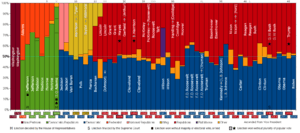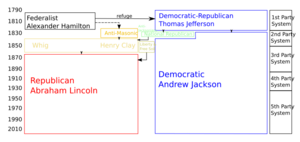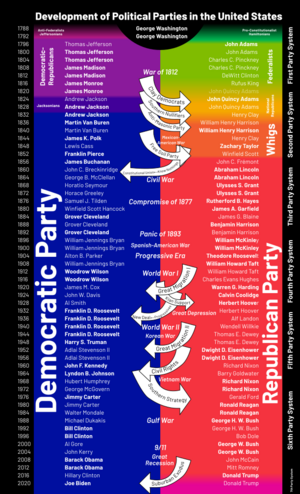Political eras of the United States facts for kids
The political eras of the United States are like chapters in a history book. They help us understand how the main political parties have changed over time.
The U.S. Constitution doesn't mention political parties at all. The Founding Fathers didn't plan for parties to exist. Important leaders like Alexander Hamilton and James Madison even wrote about the dangers of political groups.
The first President of the United States, George Washington, wasn't part of any political party. He hoped parties wouldn't form, fearing they would cause conflict. He shared these worries in his Farewell Address.
Contents
First Party System
The "First Party System" started in the 1790s. It began with George Washington's re-election in 1792 and John Adams' election in 1796. This era ended in the 1820s with the elections of 1824 and 1828. These elections led to Andrew Jackson becoming president.
George Washington's Cabinet
The idea of a two-party system in America began with George Washington's closest advisors. They split into two main groups:
- Federalists — Led by John Adams and Alexander Hamilton.
- Democratic-Republicans — Led by Thomas Jefferson and James Madison.
It's interesting because Hamilton and Madison had written against political groups. Yet, they became key leaders in this new party system. By the time John Adams and Thomas Jefferson ran for president in 1796, political parties were a clear part of American life.
Era of Good Feelings
After a while, the "Era of Good Feelings" began. This was a time when there was only one major political party. But this period ended because of new disagreements.
The Panic of 1819 (a financial crisis) and a Supreme Court case called McCulloch v. Maryland brought back old arguments. People debated whether states or the federal government had more power. The Missouri Crisis in 1820 also showed deep divisions over slavery. Speaker of the House Henry Clay helped find a solution to avoid a major conflict.
Jacksonian Democracy
"Jacksonian democracy" describes a political idea from the 1800s. It came from the seventh U.S. president, Andrew Jackson. The 1824 election caused a lot of political excitement. General Andrew Jackson won the popular vote but lost in the Electoral College.
This led to a big split in the Democratic-Republican Party. One part became the modern Democratic Party in the 1830s. This group supported Andrew Jackson. The other part joined Henry Clay's Whig Party. The term "Jacksonian democracy" was commonly used by the 1830s.
Second Party System
Many historians use "Second Party System" to describe American politics from the mid-1820s to the mid-1850s. During this time, many more people voted. There were rallies, party newspapers, and strong loyalty to parties.
This system was fully active by the 1828 United States presidential election. The Federalists had almost disappeared. The Democratic-Republicans had lost their unity.
Two major parties controlled the U.S. political system:
- The Jacksonian Democrats led by Andrew Jackson. They believed in the "sovereignty of the people." This meant that the people's will, shown through voting and conventions, should guide the government.
- The Whig Party, formed by Henry Clay. This party included former National Republicans and others who opposed Jackson. Whigs supported the rule of law and protecting minority rights.
After becoming president in 1829, Andrew Jackson changed many federal institutions. His ideas became very important for the rest of the 1830s. This helped his vice president, Martin Van Buren, win the 1836 election.
In the 1840 election, the Whig Party won for the first time. General William Henry Harrison became president. However, he died shortly after taking office in 1841. John Tyler, who called himself a "Democrat," became president. He was the first vice president to become president because the elected president died.
Smaller parties during this time included:
- The Anti-Masonic Party, active from 1827 to 1834.
- The abolitionist Liberty Party in 1840.
- The anti-slavery Free Soil Party in 1848 and 1852.
Third Party System
The "Third Party System" describes the period from the 1850s to the 1890s. This era was shaped by big issues like slavery, the American Civil War, Reconstruction, race, and money.
This system was mostly controlled by the new Republican Party. This party was seen as saving the Union and ending slavery. They also supported programs like national banks, railroads, and aid to colleges.
Even though many elections from 1876 to 1892 were very close, the Democrats only won the 1884 and 1892 presidential elections. The northern and western states were mostly Republican. After 1876, the Democrats took control of the "Solid South."
Historians believe the Third Party System ended in the mid-1890s. This time saw major changes in ideas about American identity and race. This period is often called the Gilded Age.
Fourth Party System
The "Fourth Party System" refers to American politics from the mid-1890s to the early 1930s. The Republican Party was mostly in charge during this time. The only exception was when a split in 1912 allowed Democrats, led by President Woodrow Wilson, to hold the White House for eight years. This period is often called the Progressive Era.
This era began with the severe economic downturn of 1893 and the very intense election of 1896. It included the Progressive Era, World War I, and the start of the Great Depression.
The Great Depression caused a big shift in politics. This led to the Fifth Party System, where the Democratic New Deal Coalition was dominant until the 1970s.
Key issues during this time included:
- Government rules for railroads and large companies (called "trusts").
- The debate over money (gold versus silver).
- The role of labor unions and child labor.
- The need for a new banking system.
- Corruption in politics.
- The introduction of the federal income tax.
- Direct election of senators.
- Racial segregation and women's suffrage.
- Control of immigration.
Important leaders included presidents William McKinley (Republican), Theodore Roosevelt (Republican), and Woodrow Wilson (Democrat).
The Fourth Party System ended with the Great Depression, a worldwide economic crisis that started in 1929. After the Wall Street Crash of 1929, Herbert Hoover lost the 1932 United States presidential election to Franklin D. Roosevelt.
Later Systems
The party systems that came after include:
- Fifth Party System (1932–1976)
- Sixth Party System (1980–present)




